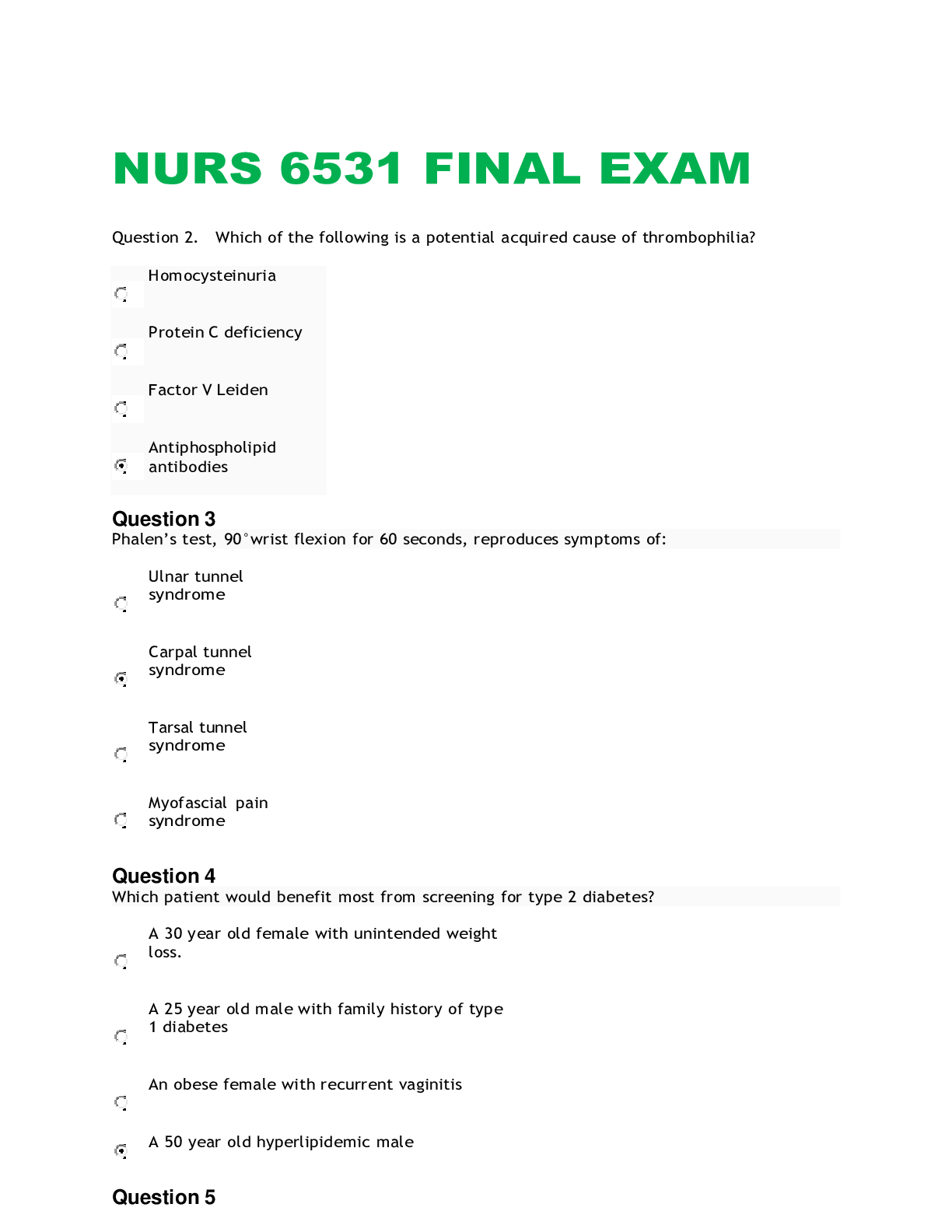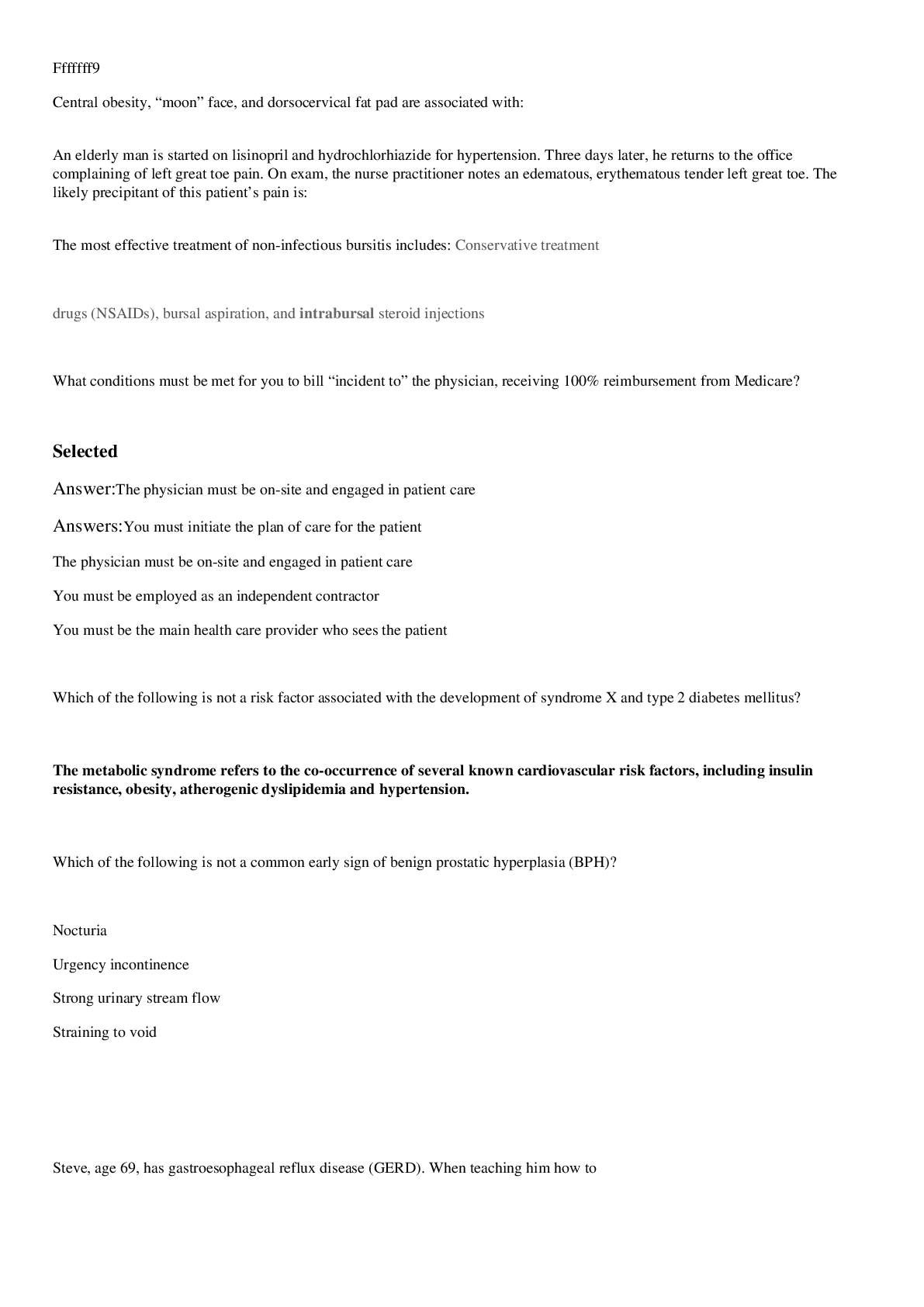*NURSING > Final Exam Review > NR511_Final_Exam_Study_Guide__11_2021___1_ (All)
NR511_Final_Exam_Study_Guide__11_2021___1_
Document Content and Description Below
NR511_Final_Exam_Study_Guide__11_2021___1_ 1. Signs and symptoms and management of musculoskeletal sprains/strains/dislocations 16-15 When Maxwell, age 12, slid into home plate while playing base... ball, he injured his ankle. The nurse practitioner is trying to differentiate between a sprain and a strain. A Alexander, age 12, sprained his ankle playing ice hockey. He is confused as to whether to apply heat or cold. What should the nurse practitioner tell him? s.” 16-69 Ankylosis is defined as 16-108 Jill, age 49, has recently begun a rigorous weight- lifting regimen. She presents to the primary care office with a shoulder dislocation. Which of the following clinical manifestations lead the nurse practitioner to suspect an anterior shoulder dislocation over a posterior dislocation? In assessing an infant for developmental dysplasia of the hip (DDH), the practitioner places the infant supine, flexes the knees by holding the thumbs on the inner mid- thighs, with fingers outside on the hips touching the greater trochanters, stabilizes one hip, and abducts and gently pulls anteriorly on the other thigh. If this external rotation feels smooth with no sound present, there is no hip dislocation. This is 16-123 Emily, age 12, presents to the clinic with another muscle strain from one of her many sports activities. The nurse practitioner thinks that the patient was probably never taught about health promotion and maintenance regarding physical activity. What information should be included in patient teaching? 16-27 Upon assessment, the nurse practitioner notes unilateral back pain that had an acute onset and increases when standing and bending. A straight- leg test is negative. The most likely differential diagnosis is 16-67 June, age 67, presents with back pain with no precipitating event. The pain is located over her lower back and muscles without sciatica, and it is aggravated by sitting, standing, and certain movements. It is alleviated with rest. Palpation localizes the pain, and muscle spasms are felt. There was an insidious onset with progressive improvement. What is the most likely differential diagnosis? 2. Signs and symptoms and management of spinal disorders (spondylosis, stenosis, etc.) 6-79 Sam, age 73, has lumbar spinal stenosis and asks which exercises he should do to help his condition. You advise him to 7-57 Clients with spinal cord injuries often have bowel incontinence and need to have a bowel program instituted. What is the most effective way to stimulate the rectum to evacuate in the quadriplegic client? 13-12 Decreased bladder capacity; bladder irritation from a urinary tract infection, tumor, stones, or irritants such as caffeine and alcohol; and central nervous system disorders or spinal cord lesions are all contributing factors to 16-50 Beth, age 49, comes in with low back pain. An x- ray of the lumbar/sacral spine is within normal limits. Which of the following diagnoses do you explore further? A. 16-72 Hilda, age 73, presents with a complaint of low back pain. Red flags in her history of a minor fall, osteopenia, and prolonged steroid use for systemic lupus erythematosus suggest the possibility of which of the following serious underlying conditions as the cause of her low back pain? 16-14 Mrs. Kelly, age 80, has a curvature of the spine. This is likely to indicate which age- related change? 16-90 What disorder affects older individuals, particularly women, and is characterized by pain and stiffness in the cervical spine and shoulder and hip girdles, along with signs of systemic infection such as malaise, weight loss, sweats, and low- grade fever? A. 3. Recognition and immediate management of cauda equina syndrome 16-11 The most common cause of cauda equina syndrome is 16-60 Sandy, age 49, presents with loss of anal sphincter tone, impaired micturition, incontinence, and progressive loss of strength in the legs. You suspect cauda equina syndrome. What is your next action? 16-72 Hilda, age 73, presents with a complaint of low back pain. Red flags in her history of a minor fall, osteopenia, and prolonged steroid use for systemic lupus erythematosus suggest the possibility of which of the following serious underlying conditions as the cause of her low back pain? 4. Maneuvers and expected findings with joint pain (knee, shoulder, wrist, etc.) Chap 16 16-24 To aid in the diagnosis of meniscus damage, which test should a nurse practitioner perform? ......................................................CONTINUED.......................................................... [Show More]
Last updated: 2 years ago
Preview 1 out of 16 pages

Buy this document to get the full access instantly
Instant Download Access after purchase
Buy NowInstant download
We Accept:

Reviews( 0 )
$13.00
Can't find what you want? Try our AI powered Search
Document information
Connected school, study & course
About the document
Uploaded On
Apr 23, 2021
Number of pages
16
Written in
Additional information
This document has been written for:
Uploaded
Apr 23, 2021
Downloads
0
Views
41

























